Additional notes (click to expand)
Medicinal
In Hawaii, the flesh of Cucurbita maxima has been used traditionally to treat skin blotches and as a laxative. Moerman (2009) also reports its use as a psychological aid in Hawaiian traditional medicine, the leaves and shoots being eaten for 'partial insanity' caused be lack of sleep.
Moerman, Daniel E. (2009) Native American Ethnobotany. Timber Press.
Restricted medicinal.
Both the flesh of the fruit and the flowers are edible, however it is the seed that is of interest medicinally. The seed oil contains fatty acids, including linoleic acid. The symptomatic relief of benign prostatic hypertrophy have been attributed to the plant sterols which are found in the seeds.
Van Wyk, Wink, BE . (2017). Medicinal Plants of the World. CABI.
Other use
Cucurbita maxima Duchesne Cucurbitaceae. Pumpkin. Distribution. North America. Seeds cooked and eaten as a treatment for tapeworms, but now a restricted herbal product, only to be supplied in registered pharmacies or under the supervision of a pharmacist (UK Medicines and Healthcare Products Regulatory Agency (MHRA)).
Oakeley, Dr. Henry F. (2013). Wellcome Library notes.
link
The tough skin of Cucurbita species makes them suitable for drying, and in many cultures they are seen repurposed as bowls, flasks, ladles and pots.
Cucurbita maxima, the winter squash, holds ceremonial importance for the Iroquois, used in feasts and at longhouse celebrations. In North American and Western Europan cultures, pumpkins appear as symbols for harvest and thanks-giving. Carved as Jack-o-lanterns, pumpkins are synonymous with the Halloween festival, with various claims to the origin of this tradition.
Moerman, Daniel E. (2009) Native American Ethnobotany. Timber Press.
Geographical distribution
- Southern America, Southern South America, Argentina Northeast
- Southern America, Southern South America, Argentina Northwest
- Southern America, Southern South America, Argentina South
Cucurbita maxima Duchesne 'Turk's Turban'
Family: CUCURBITACEAEGenus: Cucurbita
Species: maxima Duchesne
Cultivar: 'Turk's Turban'
Common names: Autumn Squash; Great Pumpkin; Winter Squash 'Turk's Turban'
Pharmacopoeia Londinensis name: Maiora Cucurbita
Distribution summary: Argentina, Uruguay
Habit: Annual
Hardiness: H2 - Tender; cool or frost-free greenhouse
Garden status: Currently grown
Garden location: Plants in pots (POT), Pharmacopoeia Londinensis 1618 'Gums, Resins, Tears' (HSE 8 B)
Flowering months: June, July
Reason for growing: Medicinal, other use
.JPG)
.JPG)
.JPG)
.JPG)
.JPG)

.JPG)
.JPG)
.JPG)
.JPG)
.JPG)
 cultivar name uncertain.JPG)